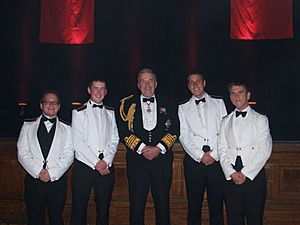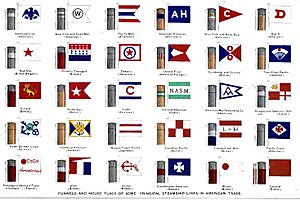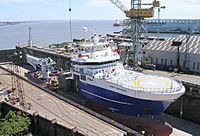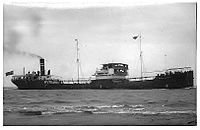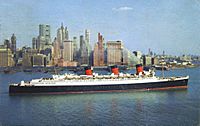Merchant Navy (United Kingdom) facts for kids
Quick facts for kids British Merchant Navy |
|
|---|---|

Badge of the Merchant Navy
|
|
| Active | 1835 – present |
| Country | |
| Type | Civil |
| Size | 10th Largest;
|
| Colours | Red |
| Fleet |
|
| Engagements |
|
| Insignia | |
| Red Ensign | |
| Civil Jack | |
The Merchant Navy is the name for all the commercial ships registered in the United Kingdom and their crews. These ships carry goods and people all over the world. Merchant Navy ships fly a special flag called the Red Ensign. The Maritime and Coastguard Agency (MCA) makes sure they follow safety rules.
King George V gave the name "Merchant Navy" to these British shipping fleets after their brave service in the First World War. Before that, it was known as the Mercantile Marine or Merchant Service.
Contents
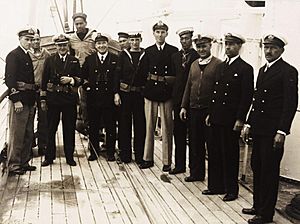
The Merchant Navy has a long history in Britain, growing because of trade and the expansion of the British Empire. It started around the 1600s when people tried to register all sailors. This was so the Royal Navy could find sailors easily during wars. This early effort didn't work well, but a successful system was put in place in 1835.
Over the years, the British merchant fleet became the biggest in the world. It benefited a lot from trading with British lands in India and the Far East. Ships like the famous Cutty Sark carried valuable goods such as sugar, spices, and tea. This helped Britain's shipping power grow even more in the 1800s.
In the late 1800s and early 1900s, special schools were set up to train officers for the Merchant Navy. For example, Leith Nautical College started in Scotland in 1855. Other colleges like South Tyneside College (founded 1861) and Warsash Maritime School (founded 1902) also began training sailors.
World Wars and Sacrifice
During the First World War and Second World War, the Merchant Navy faced huge dangers from German U-boat (submarines) attacks. These U-boats often attacked merchant ships without warning.
In the First World War, about 7.7 million tons of shipping were lost, and around 14,661 merchant sailors died. Because of their bravery and sacrifice, King George V officially gave them the title "Merchant Navy" in 1928. He also gave his son, Edward, Prince of Wales, the title "Master of the Merchant Navy and Fishing Fleets." This title has been held by British kings and queens ever since.
In the Second World War, German U-boats sank nearly 14.7 million tons of Allied ships. This included 2,828 ships. The United Kingdom alone lost 11.7 million tons, which was more than half of its Merchant Navy fleet. About 32,000 merchant sailors died during the war. However, working with the Royal Navy, these ships successfully brought in enough supplies for the Allies to win the war.
To remember these sacrifices, Merchant Navy representatives lay wreaths alongside the armed forces on Remembrance Day (November 11th). Also, September 3rd became an official day of remembrance called Merchant Navy Day in 2000.
Falklands War Service
The Merchant Navy also helped during the Falklands War in 1982. They provided 40 ships, including transport ships and tankers. Sadly, the merchant ship SS Atlantic Conveyor was sunk by a missile. It was carrying Harrier fighter jets and other aircraft. The ship's captain, Ian North, and 11 other crew members died. This was the first time a British merchant ship was lost to an armed attack since the Second World War.
For many years, the British Merchant Navy was the strongest in the world. However, with the end of the British Empire and more ships using a "flag of convenience" (registering in other countries to save money), its size has decreased. For example, in 1939, the Merchant Navy had 33% of all shipping tonnage. By 2012, it had about 3% of the world's total.
In 2012, British shipping companies owned, partly owned, or managed 1,504 ships that were 100 gross tons or more. This shows that the UK still has a significant role in global shipping.
To become an officer in the Merchant Navy, you usually need to complete three years of training called a "cadetship." This training happens at special maritime colleges in the UK, such as Warsash Maritime Academy or South Tyneside College. Cadets study subjects like marine operations or marine engineering. They also spend a year or more at sea to get practical experience.
After college and sea time, cadets take a final oral exam with a Master mariner. If they pass, they receive a certificate that allows them to work as an officer on a ship anywhere in the world. Officers can continue their studies to reach higher ranks, eventually becoming a Master (Captain).
Historically, crews on UK ships came from many different countries, depending on where the ship traded. Today, ship crews are often smaller. Many roles, like the Radio Officer, have changed or disappeared due to new technology. Now, Deck Officers are trained to use modern communication systems. Some ships also have Electro-technical Officers (ETOs) who fix and maintain complex electronic systems.
Ships display flags called ensigns at the back of the vessel or on a mast. The main flag for the Merchant Navy is the Red Ensign. Some Red Ensigns have special designs on them, but these can only be flown if the ship has a special permission.
-
The main Merchant Navy flag
Flags of British Overseas Territories
Many British Overseas Territories and Crown Dependencies also have their own versions of the Red Ensign for their ships.
Yacht Club Flags
Many yacht clubs in the UK also have their own special Red Ensigns.
-
Royal Hamilton Amateur Dinghy Club
Institution Flags
Some special organizations related to the sea also have their own Red Ensigns.
-
Ship of the National Historic Fleet
-
Registered vessel of the National Historic Fleet
House Flags
House flags are special flags designed by shipping companies. They are like a company's logo and are flown from a ship's mast.
Many interesting people have been part of the Merchant Navy.
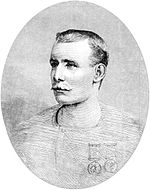

Here are a few:
- Joseph Conrad: A famous author who was a Captain in the Merchant Navy before he started writing books.
- James Cook: A famous British explorer.
- Victoria Drummond: Britain's first woman ship's engineer.
- Freddie Lennon: A steward whose son, John, later started the band The Beatles.
- John Masefield: A poet who served in the Merchant Navy.
- Arthur Phillip: He joined the Merchant Navy in 1751 and later founded the city of Sydney, Australia.
- John Prescott: A steward who later became Deputy Prime Minister of the UK.
- Captain Matthew Webb: The first person to swim the English Channel without any help.
Medals and Awards
Members of the UK Merchant Navy have received many important medals for their bravery. These include the Victoria Cross, George Cross, and Distinguished Service Order. They also received special campaign medals for serving in the World Wars.
During the Second World War, many Merchant Navy members received the Queen's Commendation for Brave Conduct. Lloyd's of London also gave out the Lloyd's War Medal for Bravery at Sea to 541 Merchant Navy personnel for their courage.
In September 2016, the UK Government created a new award called the Merchant Navy Medal for Meritorious Service. This medal is given to those who have shown "exemplary service and devotion to duty" in the Merchant Navy or fishing fleets. It's the first state award specifically for meritorious service in the Merchant Navy's history.
Just like in other services, the Merchant Navy has different ranks for its officers. Here are some of the main officer ranks:
| Deck Officers | Engineer Officer | Electrical Technical Officer | Ship's Medical Officer | Steward's Department Officer | |||||
|---|---|---|---|---|---|---|---|---|---|
| Master |  |
Chief Engineer |  |
N/A | N/A | N/A | |||
| Chief Officer |  |
Second Engineer |  |
Chief ETO |  |
Ship's Surgeon |  |
Chief Purser |  |
| Second Officer |  |
Third Engineer |  |
ETO |  |
Ship's Doctor or Dentist |  |
Purser |  |
| Third Officer |  |
Fourth Engineer |  |
N/A | Ship's Nurse |  |
Assistant Purser |  |
|
| Cadet Deck Officer |  |
Cadet Engineer Officer |  |
Cadet Electrical Officer |  |
N/A | N/A | ||
British Shipping Companies
The British Merchant Navy is made up of many different private shipping companies. Some have been around for a long time, while others have merged or changed names. The UK Chamber of Shipping in London represents British shipping companies.
Here is a list of some British shipping companies, both past and present:
- Aberdeen Line
- Anchor Line
- Anglo-Saxon Petroleum Company (Shell Tankers)
- Atlantic Steam Navigation Company
- Ben Line
- Bibby Line
- Blue Funnel Line (Alfred Holt)
- Blue Star Line
- Booth Steamship Company
- British India Steam Navigation Company
- British Tanker Company
- Caledonian MacBrayne
- Carisbrooke Shipping
- The China Navigation Company
- Clan Line
- Coast Lines
- William Cory and Son
- Cunard Line
- Eagle Oil and Shipping Company
- Elder Dempster Lines
- Ellerman Lines
- Furness Withy
- Fyffes Line
- Global Marine Systems
- Harrison Line (T&J Harrison)
- Houlder Brothers and Company (Houlder Line)
- Indo-China Steam Navigation Company Ltd.
- Isle of Man Steam Packet Company
- Isles of Scilly Steamship Company
- Lamport and Holt
- London & Overseas Freighters
- Manchester Liners
- Ocean Steam Navigation Company (White Star Line)
- Orient Steam Navigation Company
- Palm Line
- Pacific Steam Navigation Company
- Peninsular and Oriental Steam Navigation Company (P&O)
- Port Line
- Red Funnel Line
- Royal Mail Steam Packet Company
- Wightlink
- Shaw, Savill & Albion Line
- Silver Line
- Stag Line
- Star Line
- Stephenson Clarke Shipping
- Townsend Brothers Ferries
- Union-Castle Line
- United Africa Company
- Andrew Weir and Company
- Wilson Line
See also
- Equivalent Royal Navy ranks in the Merchant Navy
- His Majesty's Coastguard
- List of merchant navy capacity by country
- Ratings in the Merchant Navy (United Kingdom)
- Royal Naval Reserve
- Transport in the United Kingdom
- United States Merchant Marine
- Witherby Publishing Group




